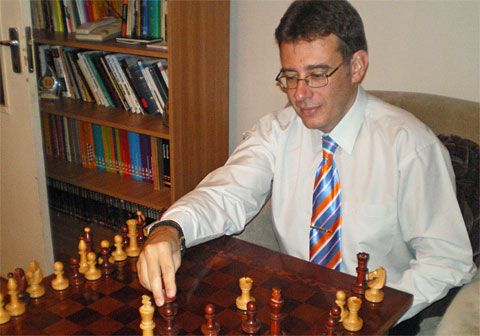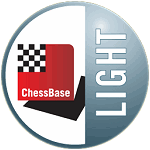
World Championship 2007 Mexico
The World Championship 2007 will take place from September 12 to 30 in the
Sheraton Centro Histórico Hotel in Mexico City. Eight players are qualified
– the tournament will be a double round robin. The prize fund is US $1.3
million.
Commentary by GM Mihail Marin

GM Mihail Marin in his analysis kitchen at home in Romaina
The following express commentary was provided by Romanian Mihail Marin,
who is the author of a number of very popular ChessBase training CDs and articles
for ChessBase Magazine. GM Marin will study the games of the World Championship
tournament in much greater detail and provide the full results of his analysis
in the next issue of ChessBase
Magazine.
Round thirteen commentary by GM Mihail Marin
The tension did not seem to diminish as we approached the finish. The only
relatively short game was Gelfand-Kramnik, but the draw was agreed in a position
where there was practically nothing left to play for.
Playing with black again, Anand carried out a risky opening experiment against
Grischuk and had to suffer in a rook ending before reaching a draw. In Aronian-Svidler,
White chose a less common variation, leading to a tense positional fight with
about equal chances. After a short tactical phase, the game transposed to a
drawn queen ending.
In the only decisive game of the evening, Leko employed a new idea right after
the opening. Black was probably OK, but Morozevich did not react in the best
way and went down rather quickly.
Gelfand,Boris - Kramnik,Vladimir [D47]
Wch Mexico (13), 28.09.2007 [Mihail Marin]
1.d4 d5 2.c4 c6 3.Nc3 Nf6 4.e3 e6 5.Nf3 Nbd7 6.Bd3 dxc4 7.Bxc4 b5 8.Bd3
Bb7 9.a3 b4 10.Ne4 Nxe4 11.Bxe4 bxa3 12.0-0
12...Nf6. A new move in Kramnik's games. Against Topalov in Elista, he
played 12...Bd6 and only after 13.b3 he attacked the enemy bishop with 13...Nf6
. Topalov came up with the novelty 14.Nd2!? highlighting the drawbacks of the
bishop's early development to d6.
13.Bd3 axb2. Gelfand had some experience
against 13...Be7.
14.Bxb2
14...a5. A new idea in this position. Kramnik delays the development of
the f8-bishop, preparing the advanced b4-square for it. 14...Be7 would transpose
to an older game by Kramnik, against Ivanchuk at New York 1994.
15.Qa4 Bb4
16.Ba3 Nd5 17.e4 Nb6 18.Qb3 Qe7 19.Rab1 Bxa3 20.Qxb6 Bb4 21.Ne1 0-0 22.Nc2 Rfd8
23.Nxb4 axb4 24.Qxb4 Qxb4 25.Rxb4 Ba6 26.Bxa6
White's advantage is purely symbolic. 1/2-1/2. [Click
to replay]
Grischuk,Alexander - Anand,V [D43]
Wch Mexico (13), 28.09.2007 [Mihail Marin]
1.d4 d5 2.c4 c6 3.Nf3 Nf6 4.Nc3 e6 5.Bg5 h6 6.Bh4 dxc4 7.e4 g5 8.Bg3 b5.
One of the fashionable lines in Mexico. 9.Be2 Bb7 10.h4. Kramnik
prefers to refrain from this move. In Mexico, 10.0-0 was played in the games
Kramnik-Gelfand and Kramnik-Anand. 10...g4 11.Ne5
11...Rg8. Against Aronian, Anand defended his pawn with 11...h5 in a similar
situation. With his last move, Black hopes to get some play along the g-file.
12.Nxg4 Nxg4. Optically, this exchange looks a bit premature, because
it allows White activate his bishop. However, the move had been played before
and we should give Anand credit for using it. The main alternative is 12...Nbd7
A few years ago, Grischuk played like this himself, eventually choosing a similar
plan as Anand in the present game: 13.Nxf6+ Nxf6 14.Bf3 b4 15.Ne2 c5 16.d5 with
advantage for White, although Black eventually won in Potkin-Grischuk, Krasnoyarsk
2003.
13.Bxg4 b4. A rare continuation. Advancing pawns with the queenside
undeveloped yet looks a bit like playing with fire. The main line goes 13...Nd7.
14.Na4 c5
15.d5!? This ambitious move has only been played once before, in a game
where the difference of level between opponents was quite big. Normally, White
captures on c5, but this does not seem to offer an advantage. The tempting sacrifice
15.Bxe6!? fxe6 16.Qh5+ Ke7 17.Nxc5 can be met adequately with 17...Rxg3! 18.fxg3
Qxd4 , when White's king would feel insecure, too. When advancing the d-pawn,
Grischuk must have remembered the problems he had in a similar situation with
Black, in his game against Potkin.
15...exd5 16.exd5 Qxd5 17.Qxd5 Bxd5 18.0-0-0
Rxg4 19.Rxd5 Nd7 20.Re1+ Kd8 21.Red1 Rd4 22.R1xd4 cxd4 23.Rxd4 Rc8 24.Bd6
Despite mass simplifications, White's position remains slightly more pleasant,
because of his more compact structure and the vulnerability of Black's queenside
pawns.
24...Ke8?! With hindsight, this move looks inaccurate, because
it allows White drive the black knight on an unfavourable position. Quite possibly,
a better way to maintain the tension would have been. 24...Be7 25.Kc2 Rc6 when
after 26.Bxe7+ Kxe7 , Black's rook is ready to start a counterattack against White's
kingside. Ironically, the g-file had been opened for the other rook initially,
but this does not make the remaining rook less suitable for this kind of job at
all.
25.Re4+ Kd8 26.Bxf8 Nxf8 27.a3 bxa3 28.bxa3 Rc6 29.Nb2 Rf6 30.Re2 c3 31.Nd1
Ra6 32.Ra2 Ng6 33.g3 Rc6 34.Kc2 Ne7
Apparently, Black is just in time to defend his far advanced pawn.
35.Nxc3!!
Spectacular and... entirely possible at the same time. White gets a very promissing
ending now.
35...Nd5 36.Kd3 Rxc3+. Or 36...Nxc3 37.Rc2 , pinning the knight.
37.Kd4 a5 38.Kxd5 a4 39.Kd4 Rb3 40.Kc4 Kc8. Black misses just one tempo
to get an easily drawn position. It woule be essentila to prevent the activation
of the enemy rook. If 40...Ke8 , hoping for ...Kf8 next, White is in time to improve
the position of the rook with 41.Re2+ Kf8 42.Re3 . With his text move, Anand "hides"
the king behind his rival, but this will not work.
41.Rc2! Kd7. It appears
that the king is expsoed on c8, too. 41...Rxa3? drops the rook to the double attack
42.Kb4+!]
42.Rc3 Rb2 43.Rf3 Ke6 44.g4 Ke7 45.Kd5 Rb3 46.Ke4 Rb2 47.Kf5 Rb5+
48.Kf4 Kf6 49.Rd3 Rb2 50.f3 Ra2 51.Ke4 Rh2 52.Rd4. It is not easy to give
a definitive verdict without a deeper analysis, but I believe that this exchange
of pawns reduces White's winning chances. I would prefer 52.h5 followed by the
king's transfer to the queenside, when Black's kingside counterplay is not that
easy to carry out. In many cases, ...Kg5 followed by ...f5 can be answered by
a rook lift to the 5th rank, pinning the f-pawn.
52...Rxh4 53.Rxa4 Rh1 54.Rb4
Ra1 55.a4 Kg6 56.Kd5 Ra3 57.Kc6 Rxf3 58.a5 f5 59.a6 Ra3 60.gxf5+ Kxf5 61.Kb6 h5
62.Rb5+ Kg4 63.Ra5 Rf3 64.a7 Rf8 65.a8Q Rxa8 66.Rxa8
White has won the enemy rook, but will miss just one tempo to win. 66...h4
67.Kc5 h3 68.Kd4 h2 69.Rh8 Kg3 70.Ke3 Kg2 71.Rg8+ Kf1 72.Rh8 Kg1 73.Rxh2 Kxh2
1/2-1/2. [Click to replay]

Video report of the
round, press conference with Anand [by Vijay Kumar]
Aronian,Levon - Svidler,Peter [A29]
Wch Mexico (13), 28.09.2007 [Mihail Marin]
1.c4 e5 2.Nc3 Nf6 3.Nf3 Nc6 4.g3 Bc5
5.Nxe5!? This move made part of Botvinnik's repertoire. The normal continuation
is 5.Bg2.
5...Bxf2+ 6.Kxf2 Nxe5 7.e4 c5 8.h3 0-0 9.d3 a6 10.Bg2 b5 11.Rf1 d6
12.Kg1 h6 13.b3 Be6 14.Be3 Rb8 15.Ne2 Re8 16.Rc1 Bd7 17.Rc2
White has the pair of bishops and some advantage of space in the centre. However,
Black's stability on dark squares ensures him a normal game.
17...bxc4 18.dxc4
Bc6 19.Nc3 Rb7 20.Rcf2 Nh7 21.h4. I am not sure whether preventing the knight
jump to g5 is worth weakening the g4-square.
21...Rbe7 22.Rd2 Qa5 23.Qc2.
But now, the g4-square is left entirely to Black's mercy, allowing him toobtain
good counterplay. 23.Nd5 would have maintained some pressure.
23...Ng4 24.Bf4
Nhf6 25.Re1
25...d5! 26.e5 Nxe5 27.Rde2 d4 28.Bxe5 Bxg2 29.Bxf6 Rxe2 30.Rxe2 Rxe2 31.Qxe2
gxf6
The position looks spectacular, but it will all end with perpetual. 32.Qg4+
Kf8 33.Qc8+ Ke7 34.Kxg2 dxc3 35.Qb7+ Kd8 36.Qd5+ Kc8 37.Qc6+ Kb8 38.Qe8+ Kb7
39.Qe4+ Kc8 40.Qc6+ Kb8 41.Qe8+ Kb7 42.Qe4+ Kc8 43.Qc2 Qa3 44.Qxc3 Qxa2+ 45.Kf3
Qb1 46.Qe3 It will be Black now who will start checking. 1/2-1/2.
[Click to replay]
Leko,Peter - Morozevich,Alexander [B80]
Wch Mexico (13), 28.09.2007 [Mihail Marin]
1.e4 c5 2.Nf3 d6 3.d4 cxd4 4.Nxd4 Nf6 5.Nc3 Nc6 6.Bg5 e6 7.Qd2 a6 8.0-0-0
Bd7
9.f3!? The main continuation in this old, but not at all out of fashion
variation is 9.f4 b5 10.Bxf6 gxf6 . With his move, Leko aims to transpose to positions
that are chracteristic for the Scheweningen English Attack, a system he masters
quite well.
9...Be7 10.Be3. After this bishop retreat, it might look as
if White has just lost a tempo compared to the English Attack. However, it is
not entirely clear whether the presence of the bishop on d7 is favourable for
Black. In certain cases, it would just deprive the king's knight from its most
natural retreat square.
10...h5!? This radical way of preventing g4 has
been played also in the Najdorf and Scheweningen 6.Be3 systems.
11.Kb1 Qc7
12.Nxc6!? A new move.
12...bxc6. Morozevich consolidates his centre,
but 12...Bxc6 would have been a simple way to justify the bishop's presence to
d7.
13.Bf4 e5 14.Bg5 Be6 15.Bxf6 gxf6 16.f4
16...a5?! I believe that Morozevich' reluctance to release the tension
in the centre is the main cause for his future problems. 16...exf4!? would have
ensured the light-squared bishop's stability on e6 and an excellent outpost on
e5 for any of the major pieces (preferably the queen). Black would have retained
chances for a queenside attack. Las negras hubieran mantenido posibilidades de
ataque en el flanco de dama.
17.f5! Bd7 18.a4 Rb8 19.Bc4! This move highlights
the main drawback of Black's 16th move. After the bishop's transfer to b3, Black's
attack will be completely extinguished.
19...Rb4 20.Bb3 Qb6 21.Rhe1 Rd4 22.Qe2
Rxd1+ 23.Rxd1 Qc5
Black has good control on dark squares, but both his bishops are passive and the
h5-pawn is weak. This latter aspect will prove of decisive importance.
24.Rd3!
h4 25.Rh3 Bd8 26.Ka2 Kf8 27.Qe1 Be8 28.Rxh4 Rxh4 29.Qxh4 Qg1 30.Qh8+ Ke7 31.h4
d5 32.exd5 Qxg2 33.h5 1-0. [Click
to replay]
All results of the round
| Round 13: Friday, Sept. 28th 2007, 14:00h |
Levon Aronian |
½-½ |
Peter Svidler |
Boris Gelfand |
½-½ |
Vladimir Kramnik |
Peter Leko |
1-0 |
Alexander Morozevich |
Alexander Grischuk |
½-½ |
Viswanathan Anand |
| |
Current standings

Links







